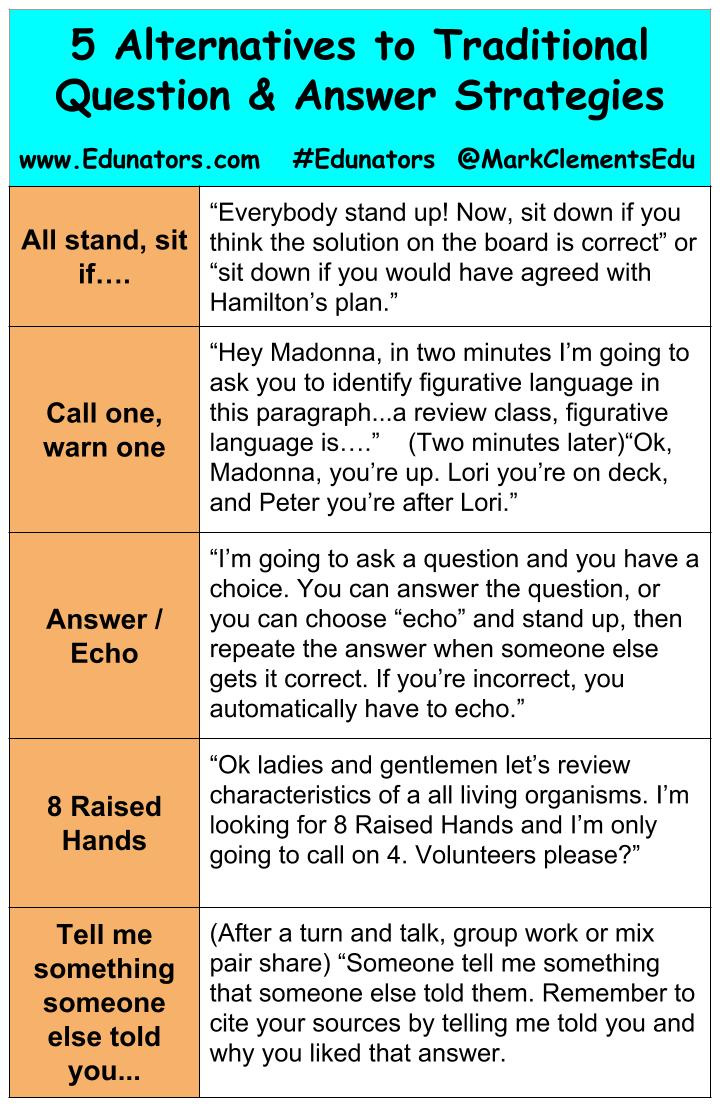 Tired of the same 3-4 kids always raising their hands to answer questions in class? Want to get a few more (or even all!) students involved in answering questions? Try some of these and let us know how they go!
Tired of the same 3-4 kids always raising their hands to answer questions in class? Want to get a few more (or even all!) students involved in answering questions? Try some of these and let us know how they go!
1. All stand, sit if….
Example: “Everybody stand up! Now, sit down if you think the solution on the board is correct” or “sit down if you would have agreed with Hamilton’s plan.”
Pros: I love doing this when the students desperately need to move, and they almost always do. No complicated directions, just a chance to stand up and stretch. I always do several in a row as well, starting with something silly, such as “Everybody stand up….now sit down if you can’t wait until lunchtime” or something similar.
It’s great for formative assessment (individual or whole group) and you get much more honest answers than you would if you flipped it by asking “stand up if you think...” since some students will prefer to stay seated and others take the opportunity to stand up no matter what.
Cons: It can be a little tricky to ask anything with a high Depth of Knowledge, since you want all students to respond at once, so it can be a little shallow, although you can deepen it by asking students to “defend” their decision to sit or stand by providing reasoning.
2. Call one, warn one
Example:“Hey Madonna, in two minutes I’m going to ask you to identify figurative language in this paragraph...a review class, figurative language is….” (Two minutes later)“Ok, Madonna, you’re up. Lori you’re on deck, and Peter you’re after Lori.”
Pros: I don’t like “cold calling” students and playing “gotcha” since I feel like it embarasses students who aren’t paying attention or don’t know the answer, and that embarrassment rarely leads to future engagement in my opinion, just hurt feelings. So if I want to hear from specific students, I’ll use this instead and give them a few moments to consider their answer (or look it up, or ask a neighbor, or something else...which is less formative that way but still great engagement). Your kiddos who are ‘on deck’ are always more attentive and you can incorporate higher order thinking questions as well.
Cons: By telling the class specifically who’s getting ready to answer the question, you run the risk of kids “checking out” when they hear it’s not going to be them.
3. Answer / Echo
Example:“I’m going to ask a question and you have a choice. You can answer the question, or you can choose “echo” and stand up, then repeat the answer when someone else gets it correct. If you’re incorrect, you automatically have to echo.”
Pros: Widespread whole class engagement as students hope to be (or not to be) picked. Great way to review a lot of material quickly, and since students can choose to “echo” I never feel as bad about cold calling them, since it’s not quite as embarrassing. It’s fun when you end up with a room full of standing students waiting for someone to get the question right so that they can echo. Easy to use as formative assessment for individual students as well.
Cons: Not great for whole class assessment. Can be a little tough to “echo” correctly, especially with younger students. Take the opportunity to teach and practice paraphrasing if it fits your topic.
4. Eight Raised Hands
Example:“Ok ladies and gentlemen let’s review characteristics of a all living organisms. I’m looking for 8 Raised Hands and I’m only going to call on 4. Volunteers please?”
Pros: The number of raised hands is flexible, as is the number of students you’re calling on. It’s a great way to temper overly enthusiastic hand raisers who tend to dominate the conversation and prevent other kids from sharing, since they still get to raise their hand and participate.
Cons: If you’ve got a class full of struggling or reluctant learners, you may find yourself waiting for a bit to get to “8” raised hands. Just keep waiting, they’ll come around eventually. :)
5. Tell me something someone else told you…
Example:(After a turn and talk, group work or mix pair share) “Someone tell me something that someone else told them. Remember to cite your sources by telling me told you and why you liked that answer.
Pros: Students who are often reluctant to share for any reason are much more likely to volunteer to share something someone ELSE told them, since it lessens the embarrassment fear of being wrong. Encourages listening during mix-pair-share types of activities, as opposed to simply waiting on their turn to talk, and increases the effectiveness of those activities.
Cons: Not as useful for formative assessment purposes as the other strategies listed here, since you never hear from individuals what their own answer/opinion was, and you don’t really hear from enough students to get a feel for the class.
Which strategy are you most eager to try out? Got a better one than the ones we listed here? Share them at Facebook.com/Edunators or on Twitter using #Edunators. Follow us @MarkClementsEdu and @Edunators for more “Edunating” content as well! Got a question or want to hear how we can help make “Eduantors” out of your faculty? Shoot me an email at This email address is being protected from spambots. You need JavaScript enabled to view it. .
More Edunating Content….
What do we do when students refuse to complete assignments?
15 Ways to Build Positive Relationships With Students
Turning Things Around: Making Your Worst Class Your Best Class

